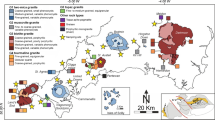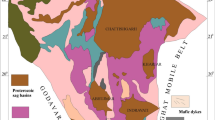Abstract
Lithium-rich brine in playas is a major raw material for lithium production. Recently, lithium isotopic ratios (δ7Li) have been identified as a tool for investigating water–rock interactions. Thus, to constrain the origin of lithium in playas by the use of its isotopes, we conducted leaching experiments on various lacustrine sediment and evaporite deposit samples collected from playas in Nevada, USA. We determined lithium and strontium isotopic ratios and contents and trace element contents of the leachate, estimated the initial δ7Li values in the water flowing into the playas, and examined the origin of lithium in playas by comparison with δ7Li values of the possible sources. In samples from the playas, δ7Li values show some variation, reflecting differences both in isotopic fractionation during mineral formation and in initial δ7Li value in water flowing into each playa. However, all δ7Li values in this study are much lower than those in river water and groundwater samples from around the world, but they are close to those of volcanic rocks. Considering the temperature dependence of lithium isotopic fractionation between solid and fluid, these results indicate that the lithium concentrated in playas in Nevada was supplied mainly through high-temperature water–rock interaction associated with local hydrothermal activity and not directly by low-temperature weathering of surface materials. This study, which is the first to report lithium isotopic compositions in playas, demonstrates that δ7Li may be a useful tracer for determining the origin of lithium and evaluating its accumulation processes in playas.




Similar content being viewed by others
References
Banner JL (2004) Radiogenic isotopes: systematics and applications to earth surface processes and chemical stratigraphy. Earth Sci Rev 65:141–194
Burton KW, Vigier N (2012) Lithium isotopes as tracers in marine and terrestrial environments. In: Baskaran M (ed) Advances in isotope geochemistry, handbook of environmental isotope geochemistry. Springer, Berlin, pp 41–59
Chan LH, Edmond JM, Thompson G, Gillis K (1992) Lithium isotopic composition of submarine basalts: implications for the lithium cycle in the oceans. Earth Planet Sci Lett 108:151–160
Chan LH, Edmond JM, Thompson G (1993) A lithium isotopic study of hot springs and metabasalts from mid-ocean ridge hydrothermal systems. J Geophys Res 98:9653–9659
Davis JR, Friedman I, Gleason JD (1986) Origin of the lithium-rich brine, Clayton Valley, Nevada. US Geol Surv Bull 1622:131–138
Davis AC, Bickle MJ, Teagle DAH (2003) Imbalance in the oceanic strontium budget. Earth Planet Sci Lett 211:173–187
Diles JH, Gans PB (1995) The chronology of Cenozoic volcanism and deformation in the Yerington area, western Basin and Range and Walker Lane. Geol Soc Am Bull 107:474–486
Falkner KK, Church M, Measures CI, LeBaron G, Thouron D, Jeandel C, Stordal MC, Gill GA, Mortlock R, Froelich P, Chan LH (1997) Minor and trace element chemistry of Lake Baikal, its tributaries, and surrounding hot springs. Limnol Oceanogr 42:329–345
Gaillardet J, Viers J, Dupre B (2003) Trace elements in river waters. In: Holland HD, Turekian KK (eds) Treatise on geochemistry, vol 5. Pergamon, Oxford, pp 225–272
Garret DE (2004) Handbook of lithium and natural calcium chloride: their deposits, processing, uses and properties. Elsevier, Oxford, p 488
Huh Y, Chan LH, Zhang L, Edmond JM (1998) Lithium and its isotopes in major world rivers: implications for weathering and the oceanic budget. Geochim Cosmochim Acta 62:2039–2051
James RH, Allen DE, Seyfried WE Jr (2003) An experimental study of alteration of oceanic crust and terrigenous sediments at moderate temperatures (51 to 350 °C): insights as to chemical processes in near-shore ridge-flank hydrothermal systems. Geochim Cosmochim Acta 67:681–691
Jones BF, Deocampo DM (2003) Geochemistry of Saline Lakes. In: Holland HD, Turekian KK (eds) Treatise on geochemistry, vol 5. Pergamon, Oxford, pp 393–424
Kisakurek B, James RH, Harris NBW (2005) Li and δ7Li in Himalayan rivers: proxies for silicate weathering? Earth Planet Sci Lett 237:387–401
Kunasz I (1974) Lithium occurrence in the brines of Clayton Valley, Esmeralda County, Nevada. Fourth Symposium on Salt—Northern Ohio Geological Survey: 57–66
Lowenstein TK, Risacher F (2009) Closed basin brine evolution and the influence of Ca–Cl inflow waters: Death Valley and Bristol Dry Lake California, Qaidam Basin, China, and Salar de Atacama, Chile. Aquat Geochem 15:71–94
Marriott CS, Henderson GM, Belshaw NS, Tudhope AW (2004a) Temperature dependence of δ7Li, δ44Ca and Li/Ca incorporation into calcium carbonate. Earth Planet Sci Lett 222:615–624
Marriott CS, Henderson GM, Crompton R, Staubwasser M, Shaw S (2004b) Effect of mineralogy, salinity, and temperature on Li/Ca and Li isotope composition of calcium carbonate. Chem Geol 212:5–15
McDermott F, Hawkesworth C (1990) The evolution of strontium isotopes in the upper continental crust. Nature 344:850–853
Millot R, Guerrot C, Vigier N (2004) Accurate and high-precision measurement of lithium isotopes in two reference materials by MC-ICP-MS. Geostand Geoanal Res 28:153–159
Millot R, Scaillet B, Sanjuan B (2010a) Lithium isotopes in island arc geothermal systems: Guadeloupe, Martinique (French West Indies) and experimental approach. Geochim Cosmochim Acta 74:1852–1871
Millot R, Vigier N, Gaillardet J (2010b) Behaviour of lithium and its isotopes during weathering in the Mackenzie Basin, Canada. Geochim Cosmochim Acta 74:3897–3912
Misra S, Froelich PN (2012) Lithium isotope history of Cenozoic seawater: changes in silicate weathering and reverse weathering. Science 335:818–823
Munk LA, Bradley D, Hynek S, Chamberlain CP (2011) Origin and evolution of Li-rich brines at Clayton Valley, Nevada, USA. Abstract V13B-2602 presented at 2011 Fall Meeting, AGU, San Francisco, California, 5–9 Dec
Nishio Y, Okamura K, Tanimizu M, Ishikawa T, Sano Y (2010) Lithium and strontium isotopic systematics of waters around Ontake volcano, Japan: implications for deep-seated fluids and earthquake swarms. Earth Planet Sci Lett 297:567–576
Price JG, Lechler PJ, Lear MB, Giles TF (2000) Possible volcanic sources of lithium in brines in Clayton Valley, Nevada. Geology and Ore Deposits: The Great Basin and Beyond Proceedings 1:241–248
Risacher F, Fritz B (2009) Origin of salts and brine evolution of Bolivian and Chilean salars. Aquat Geochem 15:123–157
Risacher F, Alonso H, Salazar C (2003) The origin of brines and salts in Chilean salars: a hydrochemical review. Earth Sci Rev 63:249–293
Schmitt AD, Vigier N, Lemarchand D, Millot R, Stille P, Chabaux F (2012) Processes controlling the stable isotope compositions of Li, B, Mg and Ca in plants, soils and waters: a review. CR Geosci 344:704–722
Stoffynegli P, Mackenzie FT (1984) Mass balance of dissolved lithium in the oceans. Geochim Cosmochim Acta 48:859–872
Tang YJ, Zhang HF, Ying JF (2007) Review of the lithium isotope system as a geochemical tracer. Int Geol Rev 49:374–388
Teng FZ, McDonough WF, Rudnick RL, Dalpe C, Tomascak PB, Chappell BW, Gao S (2004) Lithium isotopic composition and concentration of the upper continental crust. Geochim Cosmochim Acta 68:4167–4178
Tomascak PB (2004) Developments in the understanding and application of lithium isotopes in the earth and planetary sciences. Rev Mineral Geochem 55:153–195
Tomascak PB, Hemming NG, Hemming SR (2003) The lithium isotopic composition of waters of the Mono Basin, California. Geochim Cosmochim Acta 67:601–611
USGS (1996) Mineral commodity summaries 1996. US Geological Survey
USGS (2012) Mineral commodity summaries 2012. US Geological Survey, 198 p
Veizer J (1989) Strontium isotopes in seawater through time. Annu Rev Earth Planet Sci 17:141–167
Vikstrom H, Davidsson S, Hook M (2013) Lithium availability and future production outlooks. Appl Energy 110:252–266
Wunder B, Meixner A, Romer RL, Heinrich W (2006) Temperature-dependent isotopic fractionation of lithium between clinopyroxene and high-pressure hydrous fluids. Contrib Mineral Petrol 238:277–290
Yamaji K, Makita Y, Watanabe H, Sonoda A, Kanoh H, Hirotsu T, Ooi K (2001) Theoretical estimation of lithium isotopic reduced partition function ratio for lithium ions in aqueous solution. J Phys Chem A 105:602–613
You CF, Castillo PR, Gieskes JM, Chan LH, Spivack AJ (1996) Trace element behavior in hydrothermal experiments: implications for fluid processes at shallow depths in subduction zones. Earth Planet Sci Lett 140:41–52
Acknowledgements
We thank Atsushi Suzuki and Kyoko Yamaoka of National Institute of Advanced Industrial Science and Technology (AIST) and Toshihiro Yoshimura and Masakazu Fujii of The University of Tokyo for valuable discussion and helpful comments. Assistance in the laboratory was provided by Mihoko Hoshino of AIST and Junko Shimizu, Masaharu Tanimizu, Tsuyoshi Ishikawa, Kazuya Nagaishi, and Jun Matsuoka of Kochi Core Center, Japan Agency for Marine-Earth Science and Technology (JAMSTEC). We also appreciate the review by an anonymous reviewer and editorial handling by Rolf L. Romer and Bernd Lehmann. This study was supported by the Japan Society for the Promotion of Science (JSPS) Grants-in-Aid for a JSPS fellow (11J06232) to Daisuke Araoka and for Scientific Research (22224009, 16740309, 22109511) to Hodaka Kawahata and Yoshiro Nishio.
Author information
Authors and Affiliations
Corresponding author
Additional information
Editorial handling: B. Lehmann
Rights and permissions
About this article
Cite this article
Araoka, D., Kawahata, H., Takagi, T. et al. Lithium and strontium isotopic systematics in playas in Nevada, USA: constraints on the origin of lithium. Miner Deposita 49, 371–379 (2014). https://doi.org/10.1007/s00126-013-0495-y
Received:
Accepted:
Published:
Issue Date:
DOI: https://doi.org/10.1007/s00126-013-0495-y




